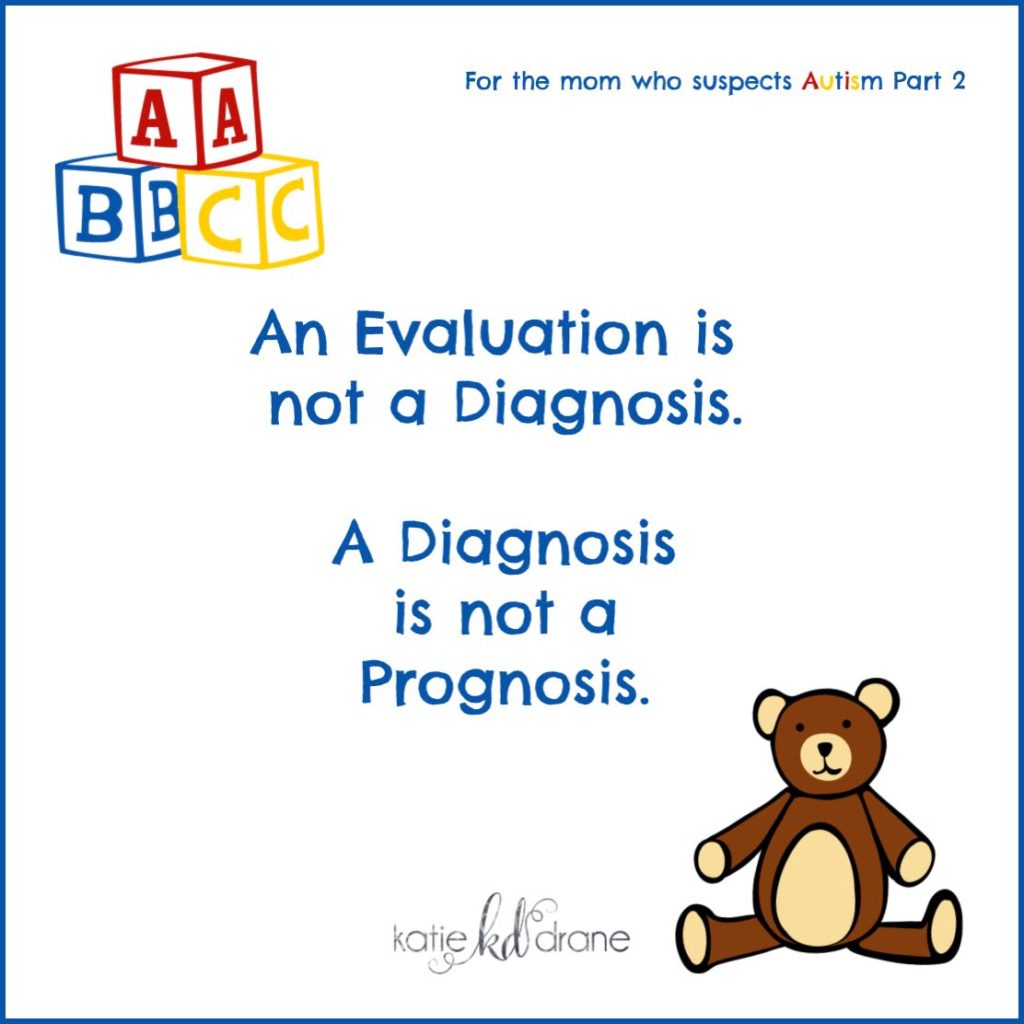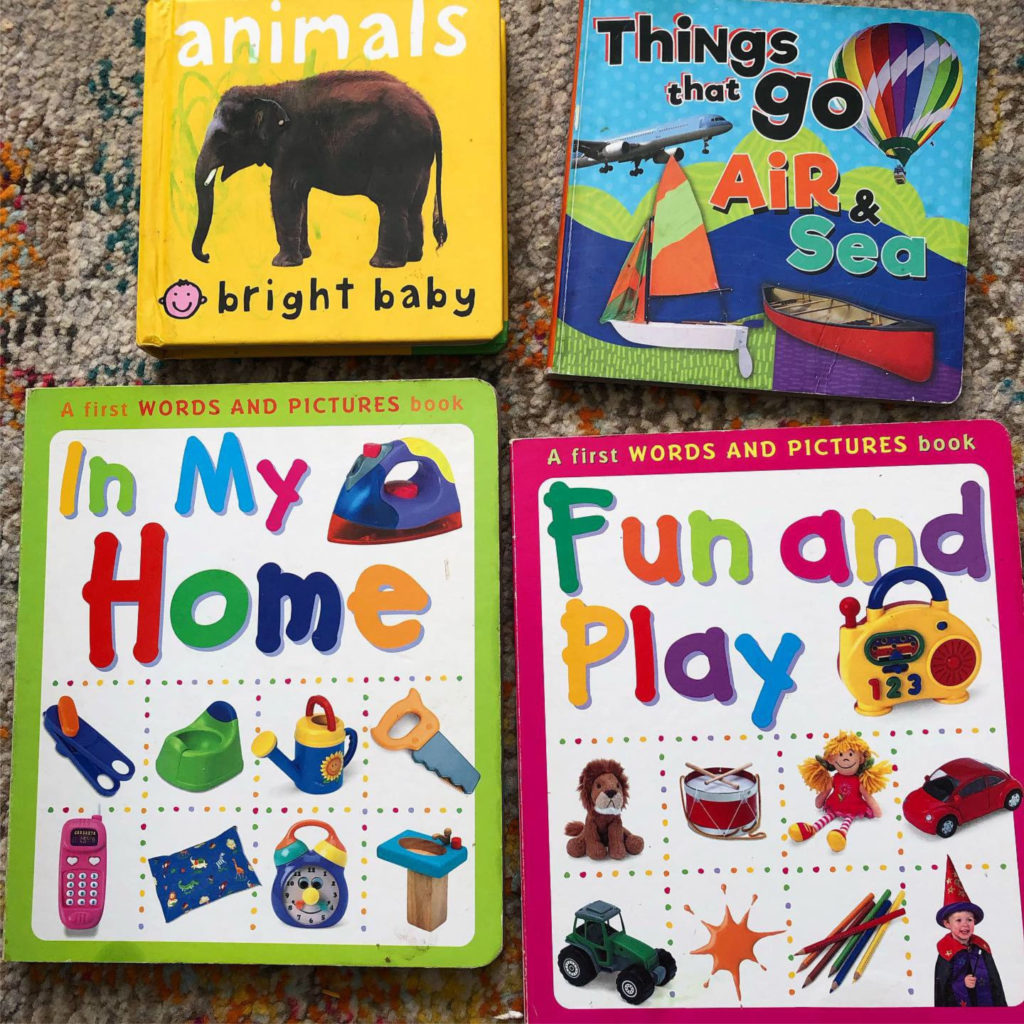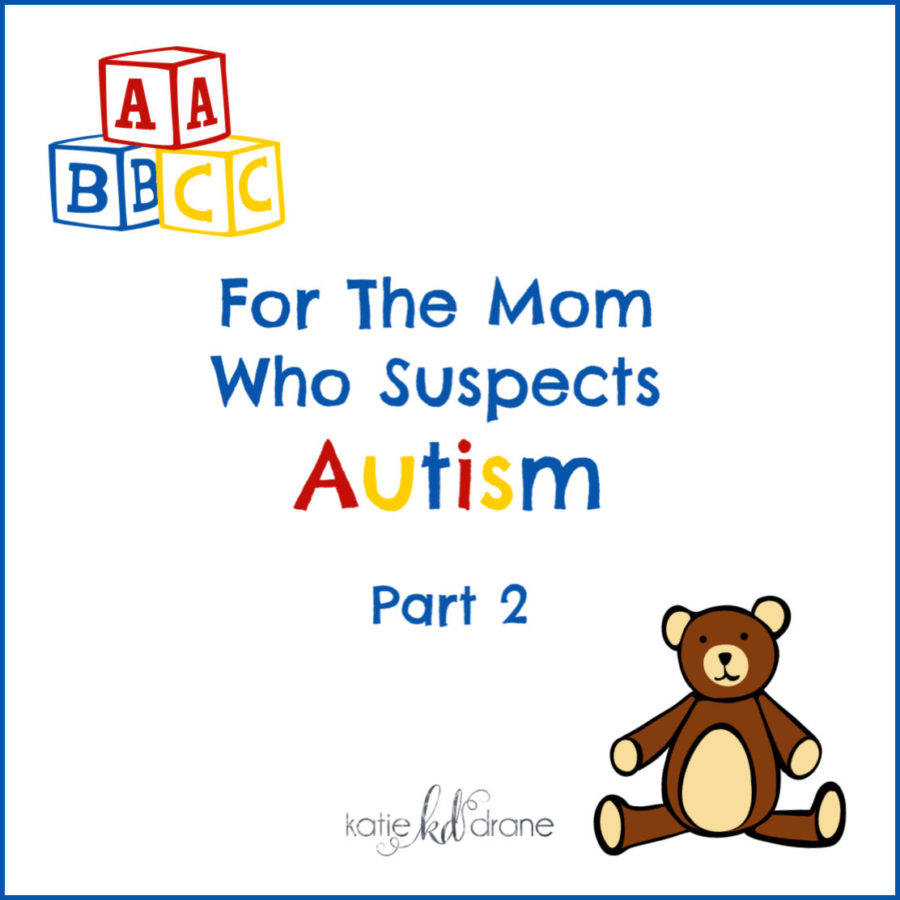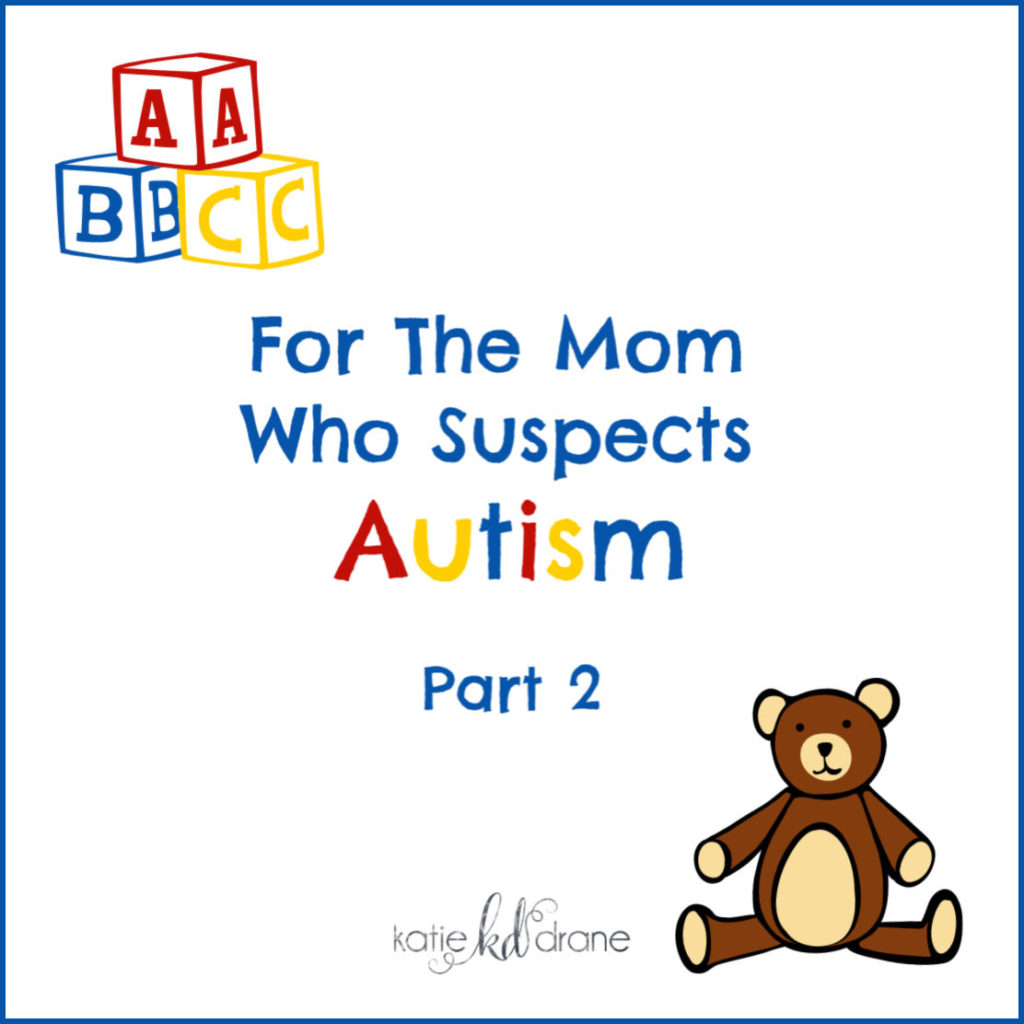Before we begin, let’s make sure you’ve completed your to-do list from Part 1.
- Completed the MCHAT-R to assess your child’s risk for autism, and probably took a look at the symptoms of autism.
- Created a timeline of behaviors, developmental milestones, and regressions (if applicable).
- Made an appointment with your pediatrician or family doctor to discuss the results of the MCHAT-R.
- Reached out to your state’s early intervention program and requested an evaluation. Note–it’s ok if you want to wait to do this step until you meet with your child’s doctor, but it’s not necessary. Parents can call directly.
If you haven’t completed these steps, please go back to Part 1 before continuing.
Part 2 was initially supposed to be about the time after completing the steps in Part 1 and before an evaluation takes place. But I added more info, because I remember needing more info during that time. There’s a lot–read it all at once, or a little at a time.
First of all, high five momma! Do you know how much courage and grit it takes just to get to this point? You’ve had a suspicion and now you’ve taken action. It’s scary, it’s unsettling, you’ve likely told people who you thought would be supportive who have responded with skepticism, criticism, or invalidation. You’re likely still going through the bazillion questions every parent asks themselves at this step in the game:
Am I overreacting?
What if they do think it’s autism?
What if it’s not autism or a developmental delay? Then what?
What do I do in the meantime?
Does this mean my child will always have to live with me?
Will they be able to make my child ‘normal’?
What will the evaluation be like? Will they judge my parenting?
It’s easy to get overwhelmed and spiral quickly when so much is unknown. While I can’t answer every single question for you, (and I shouldn’t– you’ll get better, more accurate answers from the professionals working with your child), I can give you a hand in how to deal with those thoughts and give you a few tangible things you can do NOW to help your child.

An evaluation is a positive thing.
An evaluation, though it sounds intimidating, is simply allowing 2 or more specially trained individuals to take a look at your child with objective eyes. They take into consideration what you are seeing, observe your child themselves, assess their developmental level through different activities, and make a recommendation based on all of those things. It’s information that will help you make the best possible decision for your child’s treatment and care. For more information about what to expect during the evaluation, look here.
When they ask you questions about your day, routine, sleep and eating habits, and other household-related questions, it can feel like you’re being interrogated. I promise you, you’re not. What they’re trying to do is get a clear picture of a multitude of factors that influence your child, or behaviors that your child is exhibiting that are signs of developmental issues.

I HATED admitting that Jack only ate chips, shredded cheese and mac and cheese. No matter what I served him, that’s all he would eat. I felt like the laziest, most awful mom ever. Turns out, texture and taste aversions are signs of sensory processing disorder and autism. Had I withheld that information, their recommendations for intervention would not have helped as much as they could by telling the truth.

The evaluation determines whether or not your child would benefit from early intervention services. It is not a diagnosis. (And a diagnosis is not a prognosis.)
The first words out of my mouth when the First Steps evaluators finished with both boys was “well, what do you think? Is it autism?” The truth is, they don’t know. True, they are around enough children to be able to pick up signs of an issue, but it’s too soon to tell. There’s a lot of data to assess and compare with the other professionals participating in the evaluation. It is a good idea, however, to ask questions like “what are the next steps?” or “when should I expect to hear something?” I even asked “so what should I do in the meantime?” They were more than willing to give me a few pointers. But I still had to do my homework.
So, what can you do in the meantime to help your child?
Disclaimer: As always, I have to remind you that I’m not a doctor, early interventionist, educator or therapist. I’m a parent of two boys with autism, sharing with you my experience as well as the tips, tools and strategies that worked for us during this stage of the process. If you are a parent of a child with autism, feel free to share any additional advice or experiences you have that have been helpful for you and your child.
So much of what is beneficial to a child with autism or developmental delays, is beneficial to all young children. And more than anyone else, YOU, the parent, plays the most important role in your child’s progress. So let’s go over a few things.
Play is everything.
Young children learn so much through interactive play like communication skills, cognitive skills and social skills. That’s why it’s so important to get on the floor, on your child’s level and engage in play. Now I’m not talking about anything complicated or involved. Start with 2 minutes, 4 times a day of simply playing alongside your child, doing whatever it is they are doing. Spinning cars, lining up crayons, drawing in circles…whatever it is, do what they’re doing. This simple, seemingly insignificant interaction, communicates to your child an attempt to get into their world.

Let’s talk about all those toys.
If your playroom or child’s room looks anything like mine used to, it is packed to the brim with books, toys and lots of Smart Toys (sounds, lights, talking..think battery-operated). For kids with autism (and most kids in general) all of the visual clutter, the bells and whistles, the singing and sound-effects-books, are actually discouraging children from engaging with the world. They can be overstimulating and discourage the kind of play that fosters imagination, interaction, and communication. I don’t want to go too deep into specific toys at this point, because I really think that those kind of things need to be recommended by your child’s medical and therapy providers, I will tell you a few things that worked for us:
- Instead of 30 books stuffed on a shelf, try 3. Put the rest in a bin and rotate them out. The books that work the best for the boys were ones with concrete images like this:

I think it’s important to note that I didn’t replace all of Luke’s books. One of his favorites is Cars 3, so that stays. Again, you don’t have to scrap everything you are doing now, especially if your child has favorites.
- Slowly reduce the number of smart toys in your home and replace them with toys that require your child to make them do versus do for them. Think Melissa and Doug style toys, but again, only have a few out at a time. I don’t recommend going rogue and dumping all of the Smart Toys, especially if grandparents just spent a small fortune on a birthday gift or it is one of your child’s favorites. But if you can sneak one or two out a week, you will be making great progress.
- When it comes to toys and play, simplicity is better. My friend Jessica wrote a FANTASTIC toy guide and the types of play that are most beneficial to kids. Spoiler alert–it’s so practical and common sense, you’re going to think it’s too easy. But having implemented it myself (just recently, if we’re being honest), I’m here to tell you that it works. Again, less is more.
Don’t underestimate the great outdoors.
Children get a ton of great sensory input from being outside. Everything from the feeling of grass, to the wind, to the colors, to the sounds of nature. I notice a dramatic difference in Jack and Luke’s behavior after they have been outside.

Slowly reduce and replace TV and screen time with unplugged play, but don’t lose your sanity over it.
Jack is obsessed with Blippi. Not as much as he was a year ago, but if I took that show away, threw out the TV and replaced it with a butter churn, all of us would have gone insane. Don’t do that to yourself or your child. But TV and digital games can be very overstimulating, so any reduction, even just minutes a day, will help your child.
Build your tribe and stay connected with them.
I isolated myself for a year and a half because the thought of taking both boys anywhere was too overwhelming. I didn’t keep in touch with friends, didn’t arrange playdates, didn’t let people in on how badly I was struggling because I was afraid of judgment and quite frankly, the thought of taking my screaming, biting, head-banging, rocking little guys to a playdate put me into a panic attack. I also didn’t want to see other kids their age behaving “normally’. It hurt too badly.
While it may feel safer to remain homebound, it is to your detriment and the detriment of your child. They need to experience the world outside of home, and the world needs to experience them. It’s going to be imperfect. I still get anxious when I take the boys to a playdate or a store for fear of a meltdown. But thanks to my husband Ryan who is incredibly supportive, an encouraging and supporting family (especially my mom), and a great group of friends, I know that I will never have to go through this alone.

I’ve left plenty of places in tears because of the critical comments of onlookers when the boys were melting down or just the stress of managing children with autism in public. DO IT ANYWAY. Let yourself be seen. Let people help you. Ask for help. The ones who truly love you and your family, will be honored to be included in your tribe. They want to be there for you when life gets hard.

I know that was a LOT of information. My hope is that you now have something to focus on, a job to do, that will help you as you go through the beginning stages with your child. If you missed Part 1, you can read it here.
Love and hugs to you Momma!



One thought on “For the Mom Who Suspects Autism (Part 2)”
-
Pingback: For the Mom Who Suspects Autism (Part 1) - Katie Drane
Leave a Reply